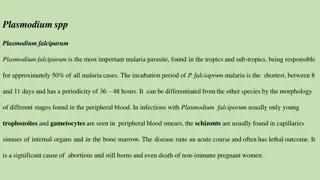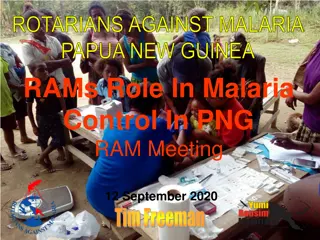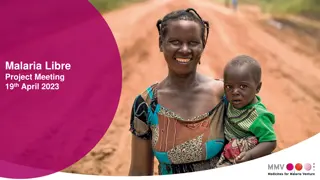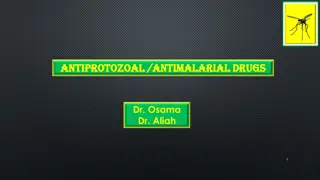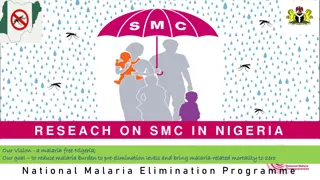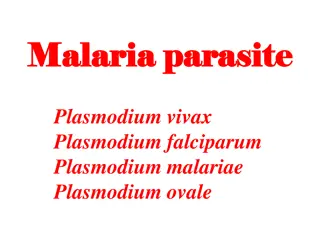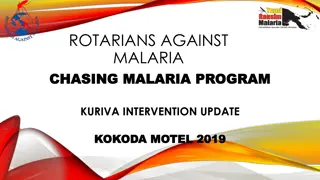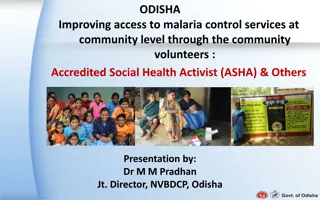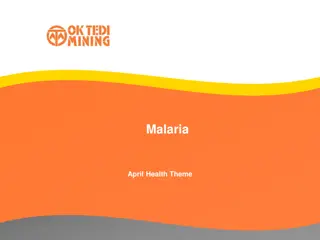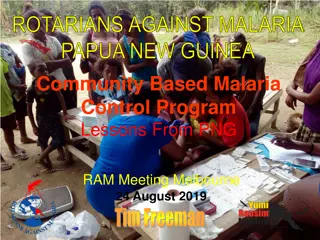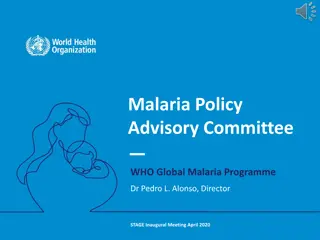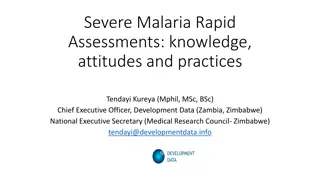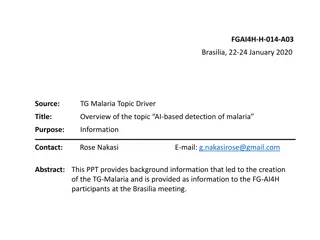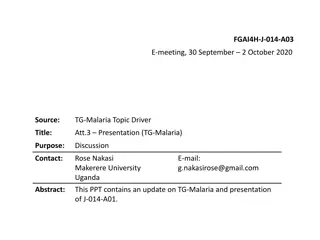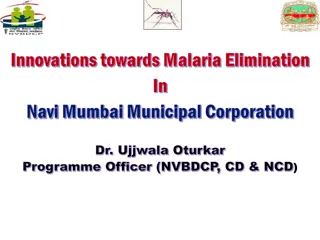Understanding Malaria & Travel: Epidemiology, Etiology, and Prevention
Exploring the epidemiology and etiology of malaria with a focus on travel-related risks. Educational objectives include gaining knowledge on malaria transmission, prevention strategies, and the importance of seeking medical advice before traveling to endemic areas.
Download Presentation

Please find below an Image/Link to download the presentation.
The content on the website is provided AS IS for your information and personal use only. It may not be sold, licensed, or shared on other websites without obtaining consent from the author. Download presentation by click this link. If you encounter any issues during the download, it is possible that the publisher has removed the file from their server.
E N D
Presentation Transcript
MALARIA & TRAVEL MALARIA & TRAVEL MEDICINE MEDICINE Awadh R. Alanazi M.D King Saud University College Of Medicine 1440--2019
EDUCATIONAL OBJECTIVES EDUCATIONAL OBJECTIVES At the end of this lecture students are expected to know: Epidemiology & Etiology. Clinical presentation. Risk to travelers. Malaria and pregnancy. Diagnostic work up. Treatment & prophylaxis.
MALARIA MALARIA EPIDEMIOLOGY EPIDEMIOLOGY In 2017, an estimated 219 million cases of malaria occurred worldwide, compared with 239 million cases in 2010 and 217 million cases in 2016. Most malaria cases in 2017 were in the WHO African Region (200 million or 92%), followed by the WHO South-East Asia Region with 5% of the cases and the WHO Eastern Mediterranean Region with 2%. Fifteen countries in sub-Saharan Africa and India carried almost 80% of the global malaria burden. Five countries accounted for nearly half of all malaria cases worldwide: Nigeria (25%), Democratic Republic of the Congo (11%), Mozambique (5%), India (4%) and Uganda (4%).
MALARIA EPIDEMIOLOGY MALARIA EPIDEMIOLOGY The 10 highest burden countries in Africa reported increases in cases of malaria in 2017 compared with 2016. Of these, Nigeria, Madagascar and the Democratic Republic of the Congo had the highest estimated increases, all greater than half a million cases. In contrast, India reported 3 million fewer cases in the same period, a 24% decrease compared with 2016. The incidence rate of malaria declined globally between 2010 and 2017, from 72 to 59 cases per 1000 population at risk. Although this represents an 18% reduction over the period, the number of cases per 1000 population at risk has stood at 59 for the past 3 years. Plasmodium falciparum is the most prevalent malaria parasite in the WHO African Region, accounting for 99.7% of estimated malaria cases in 2017, as well as in the WHO regions of South-East Asia (62.8%), the Eastern Mediterranean (69%) and the Western Pacific (71.9%). P. vivax is the predominant parasite in the WHO Region of the Americas, representing 74.1% of malaria cases.
MALARIA EPIDEMIOLOGY MALARIA EPIDEMIOLOGY In 2017, there were an estimated 435 000 deaths from malaria globally, compared with 451 000 estimated deaths in 2016, and 607 000 in 2010. Children aged under 5 years are the most vulnerable group affected by malaria. In 2017, they accounted for 61% (266 000) of all malaria deaths worldwide.
ETIOLOGY ETIOLOGY Malaria is caused by the Plasmodium parasite. The parasite can be spread to humans through the bites of infected mosquitoes (female Anopheles mosquitoes). There are many different types of plasmodium parasite, but only 5 types cause malaria in humans. Plasmodium falciparum mainly found in Africa, it's the most common type of malaria parasite and is responsible for most malaria deaths worldwide. Plasmodium vivax mainly found in Asia and South America, this parasite causes milder symptoms than Plasmodium falciparum, but it can stay in the liver for up to 3 years, which can result in relapses. Plasmodium ovale fairly uncommon and usually found in West Africa, it can remain in your liver for several years without producing symptoms. Plasmodium malariae this is quite rare and usually only found in Africa. Plasmodium knowlesi this is very rare and found in parts of southeast Asia.
PATHOGENESIS PATHOGENESIS P.F. invades RBC at all ages. P. Mal: only old RBC. P. ovale and P. vivax invade young RBC s. Microvascular pathology: secondary Ischemia Adherence of Non-deformable parasitized RBC to endothelium Renal failure: hemolysis, Ischemia secondary microvascular pathology Deep Coma: hypoglycemia, microvascular adherent parasitized RBC Pulmonary edema; 2 o: Capillary leak Synd (without C.C.F.) Immune complex Neph. Syndrome 2 o P. Malariae.
INCUBATION PERIOD INCUBATION PERIOD Sporozoites reach the liver within 1-2 hours following female Anopheles mosquito bite. Patients are asymptomatic for 12-35 days until RBCs stage of parasite life cycle.
CLINICAL FEATURES CLINICAL FEATURES Clinical features vary with: Geography. Epidemiology. Age. High risk population includes: Children. Pregnant women. Non-immune travelers to malaria endemic areas.
CLINICAL FEATURES CLINICAL FEATURES Major features: Recurring fevers Chills (Assoc. RBC lyses mature zchisonts) Periodicity S/O 48 hours: P. Vivax & Ovale 72 hours: P. Malaria Non-regular/hectic in P.F. especially in non- immune Patients (who are at highest risk of complications and death)
MALARIA PAROXYSM Paroxysms associated with synchrony of merozoite release Between paroxysms temperature is normal and patient feels well Falciparum may not exhibit classic paroxysms (continuous fever)
CLINICAL FEATURES Severe: P.F. (> 10 parasite/ mcl) AC Complications: Renal failure Coma 2 o: hypoglc; TNF, or microvascular pathology Pulmonary Edema Thrombocytopenia G. Enteritis especially diarrhea. Chronic P. Falciparum infection: Splenomegaly typically resolves after treatment with anti-malarial medications (6-12 months). P. Malariae associated Immune compl. N. Synd. P. Vivax late splenic rupture with trauma 1-3 mon. after initial infection.
MALARIA FEVER PAROXYSMS MALARIA FEVER PAROXYSMS Fever Delirium, Tachypnoea, Hot Skin (Several hours) Rigors, headache associated with pale cold skin (1-2 hours) Marked sweating and fatigue Patient often symptoms free between paroxysms
DIAGNOSIS Detailed targeted history including travel hx and clinical examination together with: High Index of Suspicion (HIS)
DX: BLOOD FILM DX: BLOOD FILM Giemsa stain or wright s stain. Correct identification of malarial Species is essential for treatment because of P. Falciparum is risitant to Chloroquine & others. On Giemsa stain Cytoplasm: light blue, nucleus: dark blue In P.F (a) only ring stage a sexual parasite and gametocytes seen in periph. blood. (b) While RBC with Trophozoites or Schizonts stage sequestered in peripheral, Microvasculature, and NOT circulating P-blood. All asexual erythrocytic stages of P. Vivax, Ovale & malariae circulate in peripheral blood, thus seen on Blood Smear Acutely ill patients DDX: P.F. vs P. Vivax, because (a) P. Ovale Vivax clinical, morphological (b) P. malariae - ch. Infeciton
THIN VS. THICK BLOOD FILM THIN VS. THICK BLOOD FILM Thin blood film: RBC morphology preserved: Thick blood film: RBC S are lysed: You may examine 10X. Blood more than in thin film. More diagnostic in lower degree of parasitemias. Serology: not useful in managing acutely ill patient. DNA probe: similar thick film sensitivity. P. Vivax; infected RBC RBC enlargement with parasite maturation. Scuffner s dots (eosinophilic dots in RBC cyto.) May see Maurer s clots in RBC ectoplasm Infection with more than one parasite spp: 5-7%
PLASMODIUM FALCIPARUM: PLASMODIUM FALCIPARUM: BLOOD STAGE PARASITES THIN BLOOD SMEARS THIN BLOOD SMEARS BLOOD STAGE PARASITES 1: Normal red cell. 2-18: Trophozoites ( 2-10: ring-stage trophozoites). 19-26: Schizonts ( 26 is a ruptured schizont). 27, 28: Mature macrogametocytes (female). 29, 30: Mature microgametocytes (male).
PLASMODIUM VIVAX: PLASMODIUM VIVAX: BLOOD STAGE PARASITES BLOOD STAGE PARASITES THIN BLOOD SMEARS THIN BLOOD SMEARS 1: Normal red cell. 2-6: Young trophozoites (ring stage parasites). 7-18: Trophozoites. 19-27: Schizonts. 28,29: Macrogametocytes (female). 30: Microgametocyte (male).
PLASMODIUM OVALE: PLASMODIUM OVALE: BLOOD STAGE PARASITES BLOOD STAGE PARASITES THIN BLOOD SMEARS THIN BLOOD SMEARS 1: Normal red cell. 2-5: Young trophozoites. 6-15: Trophozoites. 16-23: Schizonts. 24: Macrogametocytes (female). 25: Microgametocyte (male).
PLASMODIUM MALARIAE: PLASMODIUM MALARIAE: BLOOD STAGE PARASITES THIN BLOOD SMEARS THIN BLOOD SMEARS BLOOD STAGE PARASITES 1: Normal red cell. 2-5: Young trophozoites (rings). 6-13: Trophozoites. 14-22: Schizonts. 23: Developing gametocyte. 24: Macrogametocyte (female). 25: Microgametocyte (male).
DIFFERENTIAL DIAGNOSIS OF MALARIA IN ACUTELY DIFFERENTIAL DIAGNOSIS OF MALARIA IN ACUTELY III PATIENTS BASED ON P.B. SMEAR III PATIENTS BASED ON P.B. SMEAR P. FALCIPARUM P. VIVAD & P. OVALE Multiple infected RBCs Common Rare Mature (trophozoite and schizont) parasites Absent Common RBC enlargement with later parasite stages Absent Common Mature (trophozoites & schizont) stage P. falciparum. Typically sequestered in the peripheral microvasculature. RBC enlargement in P. vivax typically occurs with later stage parasites that do not circulate in P. falciparum infection.
MALARIA COMPLICATIONS MALARIA COMPLICATIONS Depth of coma. Temp. Vomiting. Seizures. Do not modify outcome Parasite load. Anemia. HIV infection did not affect clinical or biological presentation of cerebral malaria and appears not to affect outcome. (Niyongabo et al, Acta Tropica Apr 1994)
RISK FACTORS FOR POOR PROGNOSIS IN CEREBRAL RISK FACTORS FOR POOR PROGNOSIS IN CEREBRAL MALARIA MALARIA High bilirubin. High creatinine. Hight lactase.
MALARIA COMPLICATIONS MALARIA COMPLICATIONS Major clinical features of malaria are those of the complications. Majority of complications (apart from anemia) associated with P. Falciparum.
MALARIA COMPLICATIONS MALARIA COMPLICATIONS Majority of complications (apart from anemia) associated with P. falciparum *Anemia: presents in most severe infections and parallels parasitemia. Hemolysis of infected RBC. Delayed retics. release from BM. Immune mediated hemolysis of non-infected RBC.
MALARIA COMPLICATIONS MALARIA COMPLICATIONS Majority of complications (apart from anemia) associated with P. falciparum Non-immune: (primary infection). Hemoglobinuria. Black water fever . Exaggerated hemolytic response to quinine sensitized RBC.
MALARIA COMPLICATIONS MALARIA COMPLICATIONS Mild unconjugated jaundice common, and parallels hemolysis. Hepatocellular dysfunction may contribute to jaundice. Tissue hypoxia related complications: Hypoxia results from altered microcirculation + anemia. Maturation of erythrocyte schizonts in P. falciparum takes place in tissue capillaries and venules. P. falciparum parasitized RBC sequestered in micro circulation because: Altered deformability of parasitized RBC. Adhesion involving parasite derived proteins within RBC and glycoproteins on vascular endothelium.
MALARIA COMPLICATIONS MALARIA COMPLICATIONS Cerebral Malaria: Most severe common complication Renal Failure: Most severe common complication ATN. Dehydration. Hypotension. Hypervescosity. Pulmonary Edema: ARDS may complicate acute phase of severe malaise. Fluid overload may contribute.
MALARIA COMPLICATIONS MALARIA COMPLICATIONS Hypoglycemia: Glucose consumption. Lactic acidosis. Quinine/quinidine --- increase insulin secretion. Bleeding: Thrombocytopenia. Consumption coagulopathy. Shock: Endotoxemia. Diarrhea. Hyponatremia (? SIADH).
LATE COMPLICATIONS LATE COMPLICATIONS Tropical splenomegaly in P. Falciparum endemic areas. N. syndrome with P. malariae. Burkett s lymphoma (PF - EBV)
MALARIA & PREGNANCY MALARIA & PREGNANCY Mortality. Anemia, hypoglycemia, pulmonary edema: > common. Abortion. Stillbirth. Premature delivery high infant mortality. LB wt. Placental insufficiency. High parasitemia ? placenta favorable site for P. falciparum.
CONGENITAL MALARIA CONGENITAL MALARIA Transplacental infection: Can be all 4 species. Commonly P.v. and P.f. in endemic areas. P.m. infections in nonendemic areas due to long persistence of species. Neonate can be diagnosed with parasitemia within 7 days of birth or longer if no other risk factors for malaria (mosquito exposure, blood transfusion). Fever, irritability, feeding problems, anemia, hepatosplenomegaly, and jaundice. Be mindful of this problem even if mother has not been in malarious area for years before delivery.
MALARIA AND HEMOGLOBINOPATHIES MALARIA AND HEMOGLOBINOPATHIES Heterozygous sickle cell train children less likely to contract P. falciparum. C.S. disease: no such protection, rather mortality is higher > normal. Thalassemics: partially protected (? Fetal Hb) G-6-phosphatase RBC : less prone to P. falciparum.
PRINCIPLES OF TREATMENT PRINCIPLES OF TREATMENT Treatment should be guided by three main factors (CDC): The infecting Plasmodiumspecies. The clinical status of the patient. The drug susceptibility of the infecting parasites as determined by the geographic area where the infection was acquired and the previous use of antimalarial medicines.
PRINCIPLES OF TREATMENT PRINCIPLES OF TREATMENT If treatment must be initiated before the species is known treat as P .falciparum. P falciparum should be presumed to be chloroquine resistant, except in a few areas of Central America and the Middle East. Primaquine should be given if Plasmodium vivax or Plasmodium ovale is likely.
RESISTANCE PATTERNS RESISTANCE PATTERNS Chloroquine-resistant P falciparum: Eastern Hemisphere: All of sub-Saharan Africa, Saudi Arabia, Yemen, Iran, Pakistan, Afghanistan, China, Nepal, and all of Southeast Asia . Western Hemisphere: Panama, Haiti, Brazil, Peru, Bolivia, Colombia, Venezuela, Ecuador, French Guiana, Guyana, and Suriname. Chloroquine-sensitive P falciparum: Eastern Hemisphere: Turkey, Iraq, Syria, Georgia, Azerbaijan, Tajikistan, Turkmenistan, and Kyrgyzstan. Western Hemisphere: Argentina, Paraguay, Mexico, Guatemala, Costa Rica, Honduras, Nicaragua, El Salvador, and Dominican Republic.
RESISTANCE PATTERNS CONT. RESISTANCE PATTERNS CONT. Mefloquine-resistant P falciparum: Southeast Asia: Regions of Vietnam, Laos, Thailand, Burma, and Cambodia. Chloroquine-resistant P vivax: Papua New Guinea and Indonesia.
TREATMENT TREATMENT Uncomplicated P falciparum infection : Artemether-Lumefantrine or, Atovaquone-proguanil or, Quinine or, Mefloquine. Uncomplicated Plasmodium malariae, Plasmodium knowlesi, or chloroquine-sensitive P falciparum infection: Chloroquine phosphate or, Hydroxychloroquine. Uncomplicated P vivax or P ovale infection, expected to be chloroquine-susceptible: Chloroquine phosphate or, Hydroxychloroquine.
TREATMENT TREATMENT Uncomplicated P vivax infection, expected to be chloroquine-resistant: Quinine or, Atovaquone-proguanil or, Mefloquine or, Amodiaquine.
COMPLICATED MALARIA COMPLICATED MALARIA Quinidine gluconate 10 mg/kg loading dose over 1-2h, then 1.2 mg/kg/h for at least 24h. Once parasitemia is < 1% and patient can take oral medication, switch to quinine 650 mg PO TID to complete 3-d course (7-d course if malaria was acquired in southern Asia). In addition, give doxycycline 100 mg IV or PO BID for 7d. For pregnant women, instead of doxycycline, give clindamycin 20 mg base/kg/day PO divided TID for 7d.
CHEMOPROPHYLAXIS CHEMOPROPHYLAXIS Atovaquone-proguanil or, Chloroquine phosphate or, Doxycycline or, Mefloquine or, Primaquine.



